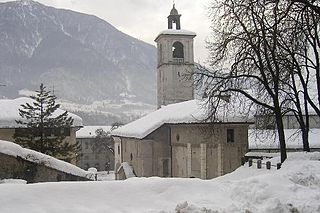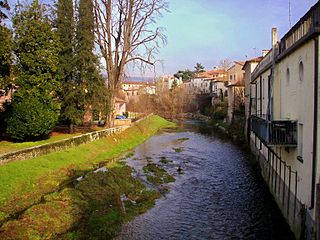
Tiziano Vecellio, Latinized as Titianus, hence known in English as Titian, was an Italian Renaissance painter, the most important artist of Renaissance Venetian painting. He was born in Pieve di Cadore, near Belluno. During his lifetime he was often called da Cadore, 'from Cadore', taken from his native region.

Vittorio Veneto is a city and comune situated in the Province of Treviso, in the region of Veneto, Italy, in the northeast of Italy, between the Piave and the Livenza rivers, borders with the following municipalities:

The province of Belluno is a province in the Veneto region of Italy. Its capital is the city of Belluno.

Feltre is a town and comune of the province of Belluno in Veneto, northern Italy. A hill town in the southern reaches of the province, it is located on the Stizzon River, about 4 kilometres from its junction with the Piave, and 20 km (12 mi) southwest from Belluno. The Dolomites loom to the north of the town.

Belluno is a town and province in the Veneto region of northern Italy. Located about 100 kilometres north of Venice, Belluno is the capital of the province of Belluno and the most important city in the Eastern Dolomites region. With its roughly 36,000 inhabitants, it is the largest populated area of Valbelluna. It is one of the 15 municipalities of the Dolomiti Bellunesi National Park.

Pieve di Soligo is a town in the province of Treviso, near the border with the province of Belluno in Veneto, Italy. As of 2023, its had 11,544 inhabitants. "Pieve" means "Parish church".

Pieve di Cadore is a comune (municipality) in the province of Belluno in the Italian region of Veneto, about 110 kilometres north of Venice and about 35 km northeast of Belluno. "Pieve" means "Parish church". It is the birthplace of the Italian painter Titian.
Zuglio is a comune (municipality), former bishopric and Latin Catholic titular see in the Regional decentralization entity of Udine in the northeastern Italian autonomous region of Friuli-Venezia Giulia, located about 110 kilometres (68 mi) northwest of Trieste and about 45 kilometres (28 mi) northwest of Udine, in the Val Bût.

The battle of Cadore, also known as the battle of Rio Secco or Rusecco, took place near Pieve di Cadore during the opening phase of the War of the League of Cambrai, part of the Italian Wars, on 2 March 1508, opposing the Venetian armies commanded by Bartolomeo d'Alviano and those of the Holy Roman Empire under the leadership of Sixt von Trautson. The battle resulted in a decisive Venetian victory, stopping the Habsburg invasion of Cadore and allowing the Venetians to reconquer all their lost strongholds as well as invade Habsburg-ruled lands in Friuli and the Julian March, besieging Trieste and marching on Istria. This would trigger the creation of the League of Cambrai and the beginning of the War of the League of Cambrai.

Mattia de Rossi was an Italian architect of the Baroque period, active mainly in Rome and surrounding towns.

The Diocese of Belluno-Feltre is a Latin diocese of the Catholic Church located in the Veneto, northern Italy, organized in its current form in 1986. From 1197 to 1762, and again from 1818 to 1986, the Diocese of Belluno and the Diocese of Feltre were united under a single bishop, with the name diocese of Belluno e Feltre. The current diocese is a suffragan of the Patriarchate of Venice.

In Italy in the Middle Ages, a pieve was a rural church with a baptistery, upon which other churches without baptisteries depended. Pieve is also an Italian and Corsican term signifying the medieval ecclesiastical/administrative territory of its the mother church. It has thus become a common component of both place names and of the names of churches.

Batignano is a small town in southern Tuscany, a frazione of the comune of Grosseto, positioned at about 10 km north-east of the capital on one of the last foot-hills of the valley of Ombrone which dominated the ancient city of Roselle.
Tolberto III da Camino (1263–1317) was an Italian nobleman and military leader, a member of the Da Camino family.
Guecellone VII da Camino was an Italian nobleman and lord of Treviso.

Antonio Dal Zòtto was an Italian sculptor.

Rocchette di Fazio is a village in Tuscany, central Italy, administratively a frazione of the comune of Semproniano, province of Grosseto. At the time of the 2001 census its population amounted to 19.

Francesco Cavrioli was an Italian sculptor, active in Venice in a Baroque style.

Giovanni Battista (Giambattista) Meduna, knight and Commander of the Order of Saints Maurice and Lazarus, was an Italian architect from Venice.






















